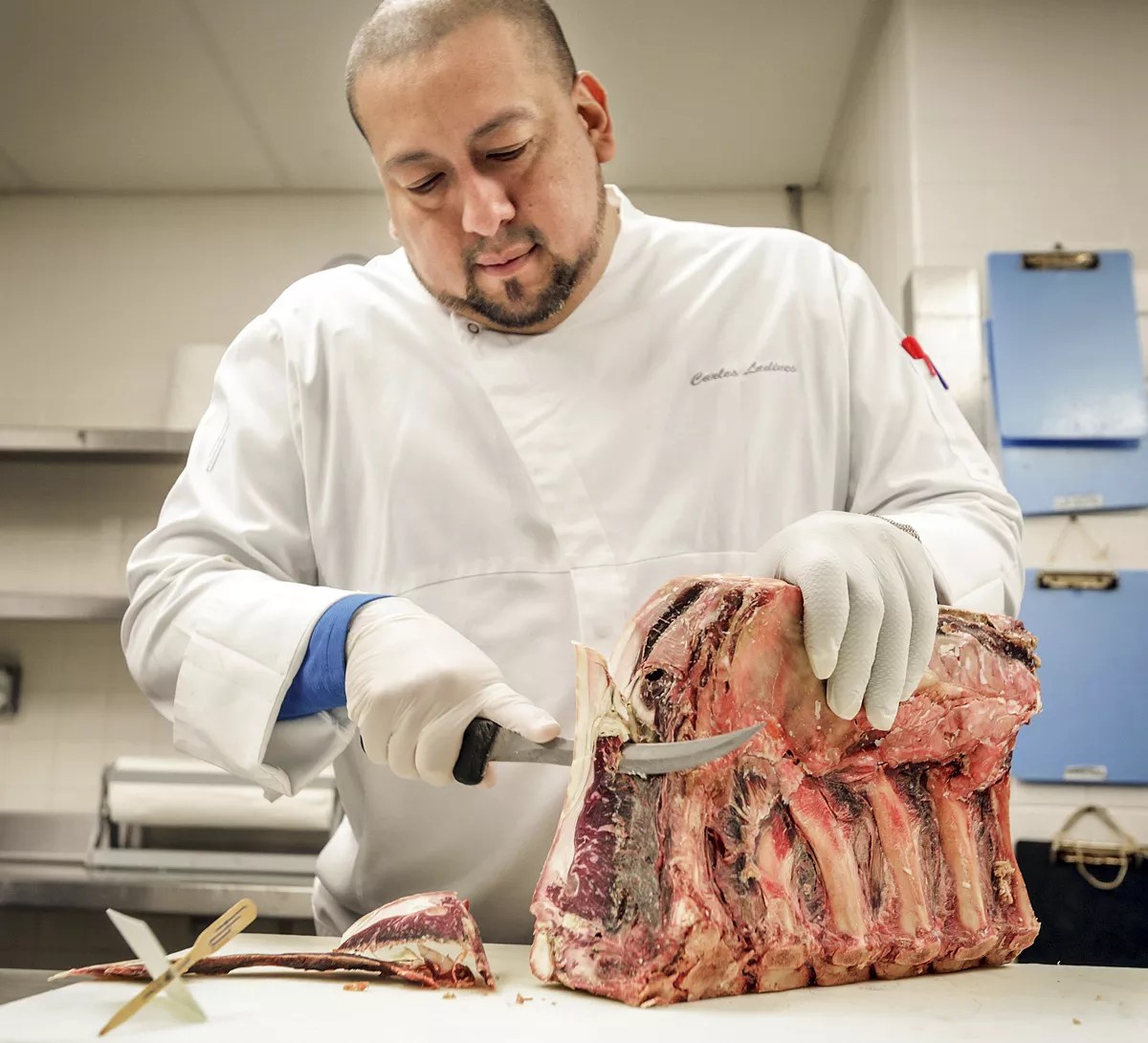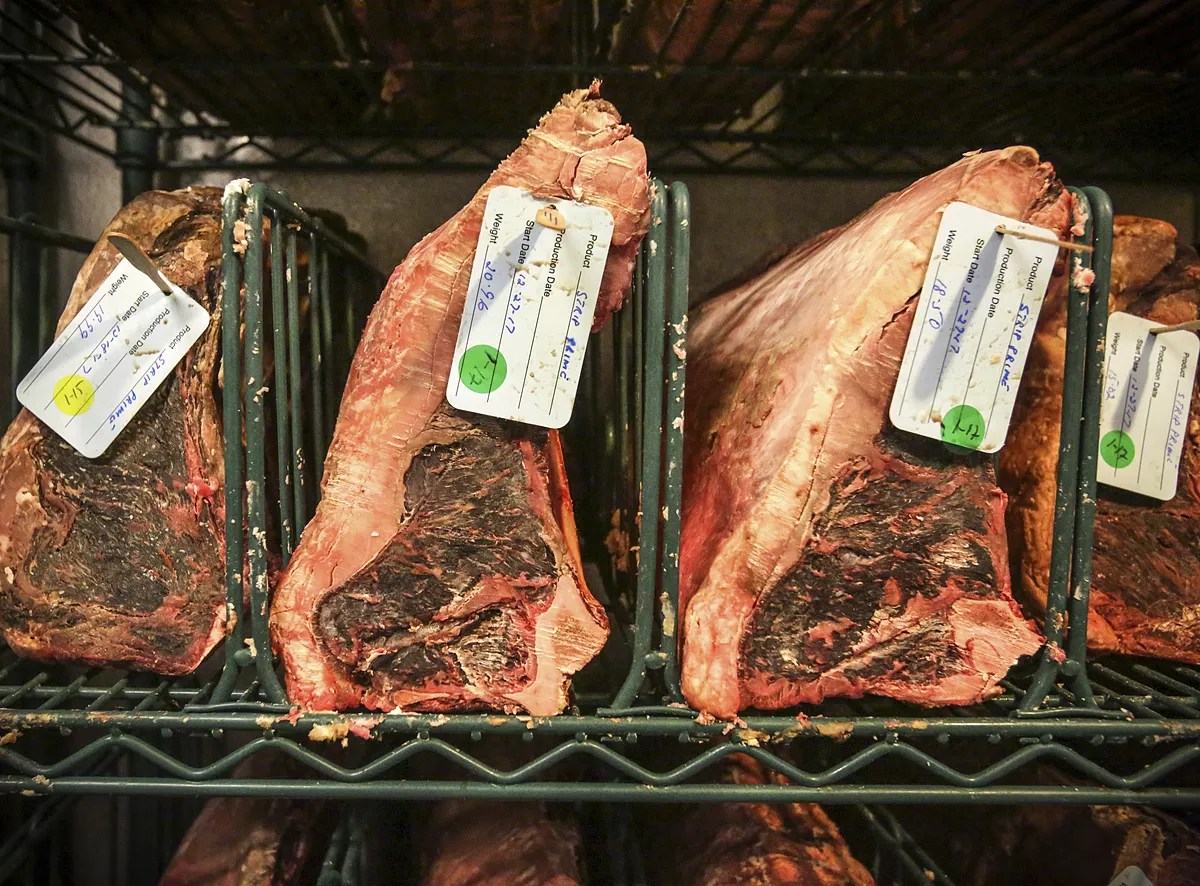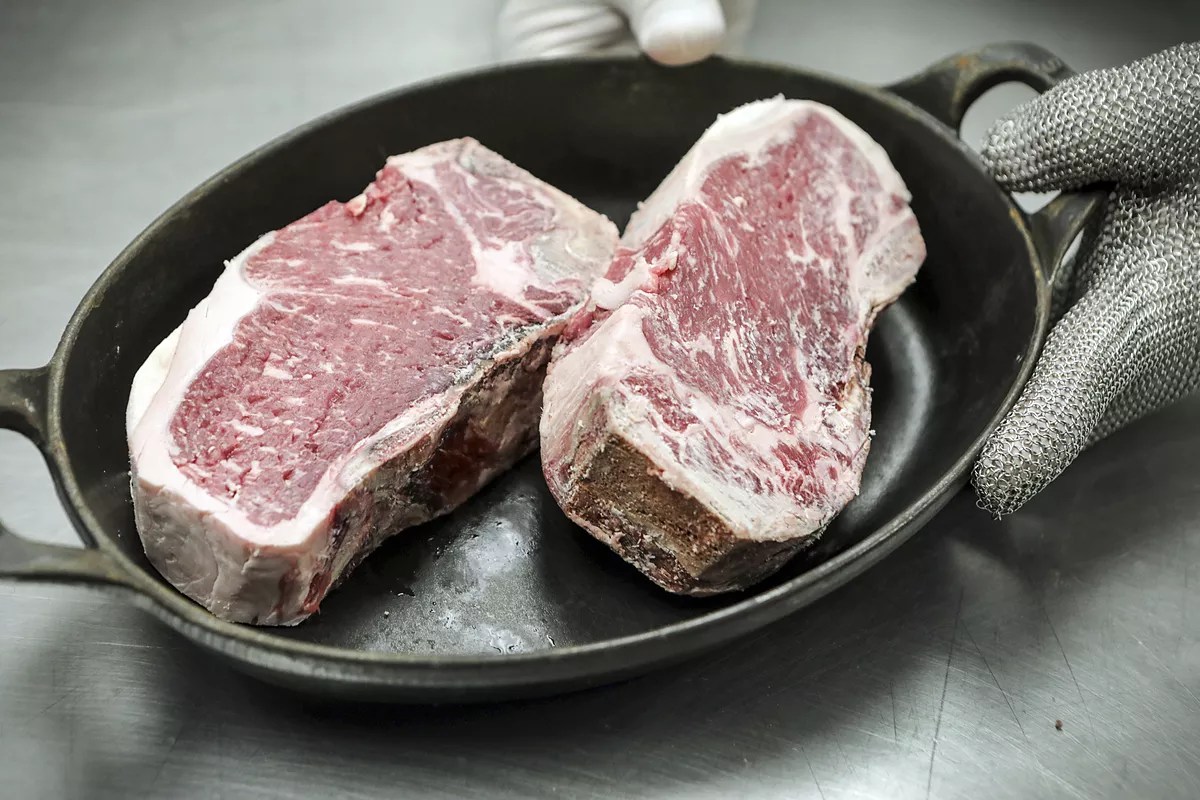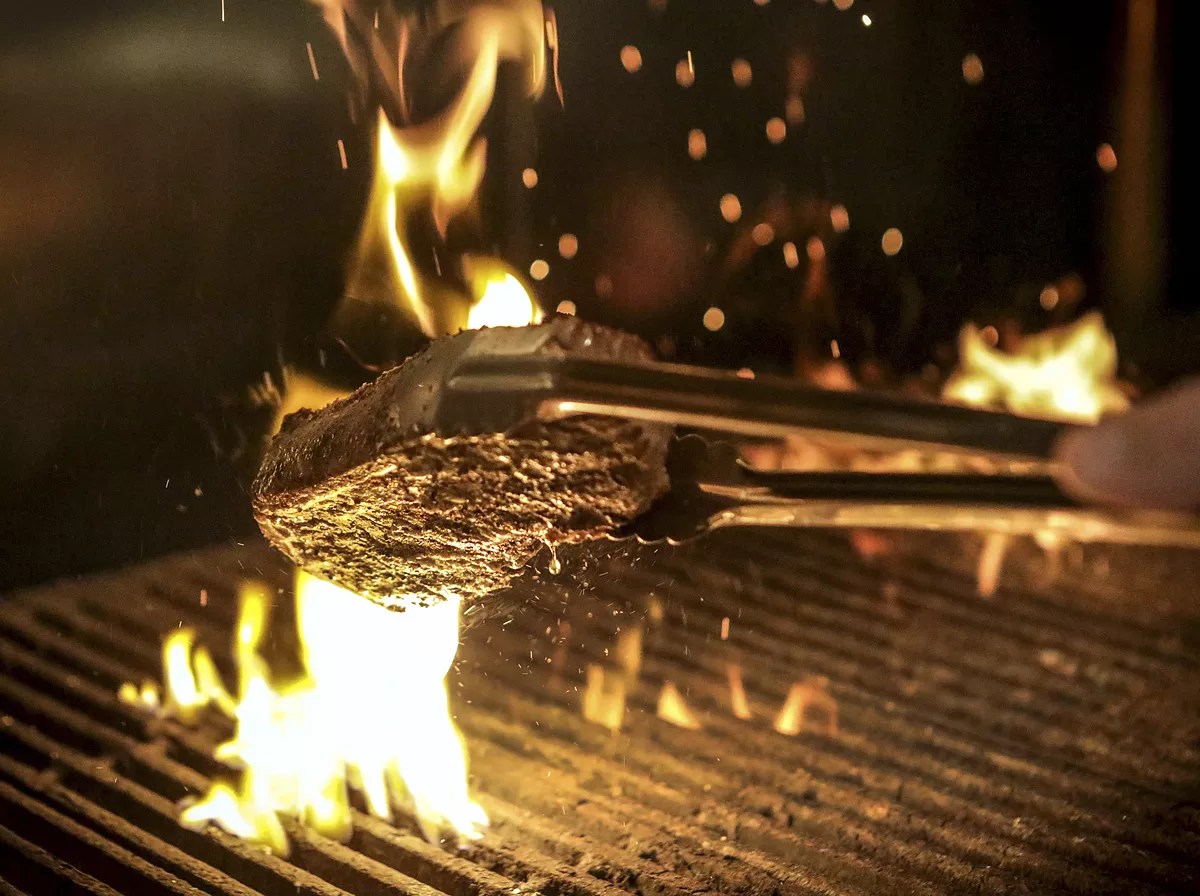
Photography by CandaceWest.com

Audio By Carbonatix
Hidden from the glittering chandeliers of the Fontainebleau Miami Beach’s lobby, almost $2 million worth of high-grade beef slowly decomposes each year.
Find it by escaping the hotel’s foyer through a camouflaged door and descending a short staircase into a hallway with piping and wires running overhead. Snaking through the underbelly, you pass the noisy employee dining hall before arriving at a frigid space where four full-time butchers carve mountains of meat. Behind them is a thick stainless-steel door guarding an eight-by-ten-foot room with precisely maintained conditions of 36 degrees Fahrenheit and 85 percent humidity. It’s a cramped closet filled with the sweet aroma of fresh blood and a scent close to roasting cashews. Steel frames are stacked with individually tagged and dated beef shoulders as well as dozens of racks of New York strip steaks and rib eyes.
At any time, the room is filled with $30,000 of meat, each steak awaiting its time to be sliced, trimmed, and served to guests who pay top dollar for a delicacy aged at least 28 days.
“The time and bacteria is what tenderizes the meat and adds that aged, nutty character to it that’s unlike anything else,” says Carlos Ladines, the Fontainebleau’s 42-year-old head butcher.
Will you step up to support New Times this year?
At New Times, we’re small and scrappy — and we make the most of every dollar from our supporters. Right now, we’re $17,250 away from reaching our December 31 goal of $30,000. If you’ve ever learned something new, stayed informed, or felt more connected because of New Times, now’s the time to give back.
South Florida seems to be turned on to the intense, nutty flavor that the meat offers.
Ladines isn’t the only one in Miami overseeing an in-house dry-aging program. When the Fontainebleau started its room about six years ago, dry-aged steaks and dry-aging programs had just begun proliferating, but now there are more.
These days, Wolfgang’s Steakhouse (3 S. Biscayne Blvd., Miami; 305-487-7130; wolfgangssteakhouse.net) is doing it downtown, while farther north, the Seminole Hard Rock’s Council Oak Steaks & Seafood (1 Seminole Way, Hollywood; 954-327-7501; seminolehardrockhollywood.com) ages meat inside a room lined with pink Himalayan salt. SoFi’s Smith & Wollensky (1 Washington Ave., Miami Beach, 305-673-2800; smithandwollensky.com) has long maintained its own program, and Brickell newcomer Nusr-Et Steakhouse (999 Brickell Ave., Miami; 305-415-9990; nusr-et.com.tr), helmed by the salt-sprinkling social media sensation Nusret Gökçe, has a sprawling dry-aging room on display for diners.
Indeed, much of South Florida seems to have turned on to the intense flavor that meat offers after a month or so in a frigid, dry room.

Prime cuts are aged for at least 28 days in the Fontainebleau’s meat locker. See more photos inside StripSteak’s dry-aging room at the Fontainebleau here.
Photography by CandaceWest.com
For centuries, butchers used dry-aging as a way to preserve meat before refrigeration. And the process by which the cows’ naturally occurring enzymes helped preserve the beef also soften it and add flavor. During a long hang in a cool, arid space, “the juices are absorbed into the meat, and chemical breakdown of protein and fat constituents occurs, which results in more intense nutty and beefy flavor,” according to a 2016 study published in the Journal of Animal Science. “Moreover, during aging, the beef’s natural enzymes break down the proteins and connective tissue in the muscle, which leads to more tender beef.”
The process comes with a cost and risk. To start, restaurants that dry-age meat can expect to lose anywhere from 20 percent to half the weight of the beef through water loss and trimming inedible parts. At the Fontainebleau, $350,000 of the $1.75 million the hotel spends on meat to be dry-aged goes straight into the garbage. Next, the conditions inside the room where dry-aging is performed need to be monitored carefully. Any moisture can lead to rot.
Thus, it takes years to learn to dry-age. Ladines began his training as a butcher two decades ago while working for the Orlando-based conglomerate Darden Restaurants. After joining the Fontainebleau ten years ago, he noticed some inconsistencies in dry-aged cuts from purveyors.
So he began testing his own program. The first thing to be mastered, he says, was the cow. “You learn which cuts are best for grilling, which are best for grinding, and how long each needs to be aged,” he explains. “After that, you learn to work with chefs and help them figure out which cuts are best for their menu.”
It’s detail-oriented work. Inside the drying room, each rack of meat is tagged with the date it enters and is regularly checked to ensure it’s evenly drying and devoid of rot. During the summer, when humidity rises, butchers need to become even more vigilant. “We bring [the cuts of meat] in, we weigh them, we tag each one with original start weight, and we’re constantly checking them,” he says.
Here, the huge shoulders that are ground for burgers are aged for about 60 days. Larger rib-eye racks go for about 35 days, and smaller ones spend around 28 days drying. A New York strip’s prime drying time is between 28 and 32 days, and the butcher shop is constantly working to ensure it has enough dry-aged meat at the right point of maturity to meet customer demand.
For dedicated carnivores, the result is well worth the $3 per ounce charged at the Fontainebleau’s steakhouse, StripSteak (4441 Collins Ave., Miami Beach; 305-674-4780; fontainebleau.com), which is overseen by Michael Mina.

See more photos inside StripSteak’s dry-aging room at the Fontainebleau here.
Photography by CandaceWest.com
Servers advise guests the wait can be up to 30 minutes for a steak. That’s how long it takes the restaurant’s chef de cuisine, William Crandall, and company to ready a cut by first poaching it in a vat of beef fat, butter, and herbs; then searing it over white oak; and, finally, allowing the meat to rest and slowly come to the appropriate temperature. The result is dramatic. A hulking, bone-in rib eye arrives with a perfect sear and a deep, rich aroma. The meat is juicy, without any of the usual bloody runoff found in a traditional steak, and boasts an intense aroma redolent of prosciutto and blue cheese.
“It’s purely flavor-focused; it’s a very chef-driven idea, like reducing a sauce or a demi-glace in order to concentrate the flavor,” Crandall explains.
And that flavor is why all of the porterhouses, rib eyes, and New York strips at Wolfgang’s Steakhouse are dry-aged.
“You don’t need to put anything on it other than maybe a little bit of salt,” Wolfgang’s executive chef Saad Miguel says. The 63-year-old with a gray military-style haircut has spent all of his professional life in steakhouses. He began at the age of 22 as a dishwasher at the Palm in New York City and two years later became chef at Manhattan Grill, where he says members of the Gotti crime family used to love to celebrate when one of their comrades was released from prison.
Miguel is highly protective of his dry-aging techniques, and it took more than an hour of cajoling to persuade him to show off the room where he does it. He aims for 28 days of aging on each cut, never fewer, but sometimes a bit more. Inside his stainless-steel walk-in cooler filled with the hum of fans, racks aren’t tagged with their entry date but their expected exit. Miguel says he is the only one who knows every detail of the process, and he guards the meat like a mother hen. See more photos inside StripSteak’s dry-aging room at the Fontainebleau here. Photography by CandaceWest.com
Knowing when a particular rack has reached maturity seems to be as much art as science, and it doesn’t come cheaply. The restaurant’s signature dry-aged porterhouse for two or more rings in at $47.95 per person, while the rib eyes go for $49.95 per person. Miguel checks the cuts regularly to ensure they’re drying evenly and rotates them throughout the refrigerator as necessary. A rack is ready when it’s firm to the touch and doesn’t leave any moisture on the fingers. “After doing it for 40 years, you learn how to look at it, what to look for, and what to smell for,” he explains while stroking his tight gray chin straps. “Eventually, you get the feeling for what’s right.”
Knowing it’s right on the plate is a far simpler task. These steaks are well worth the high cost, which easily climbs above $100 for a 32-ouncer. Though steakhouses abound in Miami, those that either dry-age their meat or at least offer a few dry-aged cuts stand out in a way that’s more important than decor, buzz, and even the wine list. Indeed, when you devour a hulking rib eye dried for 30 days or more, you might notice a slight tingling at the base of your skull. That’s your pleasure center, and the sensation is priceless.